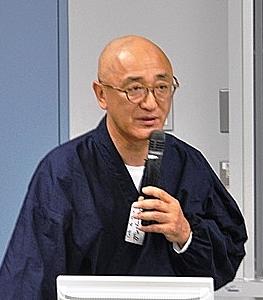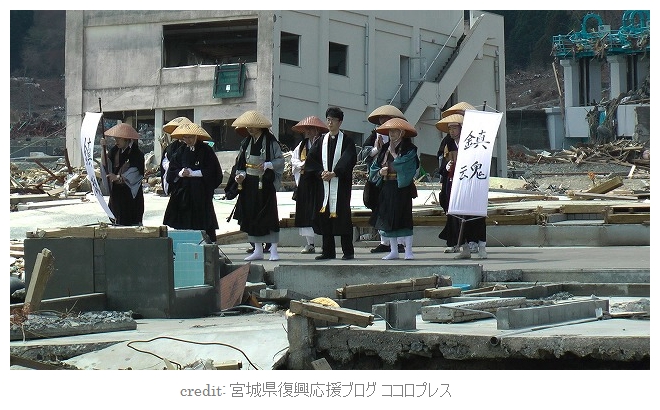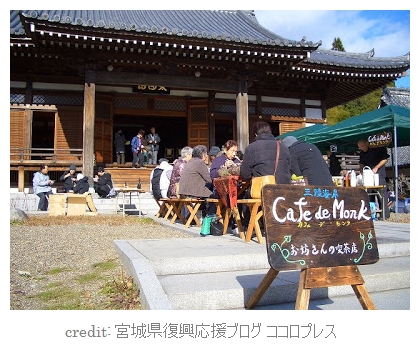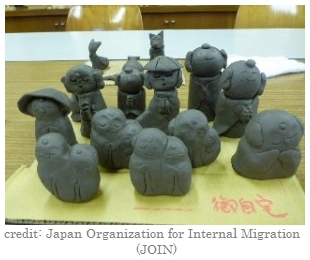2014 Level 1: Seminar 2
Listening Deeply to the Heart/Mind (kokoro/citta):
The Activities of the Cafe de Monk
October 29, 2014
Rev. Taio Kaneta

Supervisor of the Mobile Tea House for Deep Listening “Cafe de Monk”
Abbot of Tsutai-ji (Soto Zen) in Miyagi Prefecture
In facing the reality of the Great Eastern Japan Disaster of 2011, many religious professionals were at a loss for words to offer from a spiritual standpoint. What can be said about “the truth that emerges from the dark wreckage?” In this session, we will look back on the lessons learned through the activities of the Mobile Tea House for Deep Listening known as “Cafe de Monk”.
A central theme of Rev. Kaneta’s talk was the term monogatari, which generally means “myth” or “legend” but in this context more closely meant “story” or “narrative”. In this way, Rev. Kaneta pointed out that people will make various stories or narratives in order to make meaning as they go along in life. As a Buddhist priest, he has found that Buddhist rituals have enabled people in his community and in disaster areas to make narratives around loved ones who have died as a means of healing.
His first experience with this has been around the issue of suicide, for which his town of Kurihara in Miyagi Prefecture has led the nation in suicide rate since 2005. For Rev. Kaneta, suicide is a particularly difficult trauma to deal with because a person’s narrative ends and is defined in this act. In 2010, he started doing public work to raise awareness of the problem in his community, going on “dharma walks” through his town holding a banner that read simply, “life”. In this time, he has also joined the nationwide suicide prevention network of Buddhist priests called Ka-ze as well as making his own community network on the problem.
The Great Eastern Japan Earthquake and Tsunami Disaster that struck on March 11, 2011 abruptly shifted Rev. Kaneta’s work and has led him to a new level of engagement. Rev. Kaneta’s town of Kurihara is fortunately some 45 kms removed from the coast and from the effects of the tsunami. However, the earthquake registered as 7.0 in Kurihara and left them disconnected from all lifelines except for radio. Rev. Kaneta relates that while his community was not directly affected by the tsunami, it was perfectly situated to serve and support some of the worst affected towns, such as Ishinomaki. Like so many Buddhist priests in the region as well as from other parts of Japan, Rev. Kaneta threw himself into emergency religious work, such as offering spot funeral rites and services for the mass numbers of people who needed to be quickly cremated. He also participated in tsuito angya, which are groups of priests walking through the wreckage chanting for the repose of those who died in the disaster. One of these groups was a collection of priests, which included Christian priests as well, from the Rinsho Shukyo Interfaith Chaplain Training Program of Tohoku University. One of the interesting challenges this group faced was choosing a common chant among their wide variety of traditions, even among just the Buddhists.

It was, however, an encounter with a pair of Japanese doctors working for Doctors Without Borders/Medecins Sans Frontieres that made him question more deeply what he could do as a priest to help people in the disaster areas. While conducting rites at the crematoriums in the disaster areas, he noticed that people often did not cry. They seemed to be still in too much shock over the suddenness of the events. This made him think about creating a place amidst the wreckage and disaster where people could find a haven, a safe place to find even a momentary break from the ever present anxiety of their situations and perhaps begin to make sense of what was happening. Together with some other Soto Zen priests who had experience in other disasters?such as the Great Hanshin Earthquake of 1996 and the Chuetsu (2004) and Noto Peninsula (2007) earthquakes?they created the Cafe de Monk. This cafe was part of a larger movement by Soto Zen priests to adapt the traditional Zen art of tea ceremony called gyocha to a more relaxed form of sharing time and conversation among lay people and priests, especially in disaster areas. This movement spread in the aftermath of the tsunami disaster, and priests from other denominations and lay people of non-religious groups set up similar “tea time” activities in the disaster areas, especially in the emergency shelters and temporary housing complexes.
In order to create a proper context or container for holding the trauma of these people and enabling them to open up, Rev. Kaneta did much to make the cafes as enjoyable as possible. He had learned from the writings of Victor Frankl, who had survived the Nazis death camps during World War II, of the power and importance of humor in such difficult circumstances. The mobile cafes also made special efforts like brining in high class sweets from outside of the region, and Rev. Kaneta, a music lover and musician himself, likes to play recordings by the legendary jazz composer Thelonius Monk, acknowledging the play on words with name of the cafe. Thus far, they have run cafes in around 160 different locations, including Ganoku-ji in Minami-Soma, Fukushima, right on the very edge of the nuclear evacuation zone.

The deeper focus and goal of the Cafe de Monk is the practice of “deep listening” (keicho). For Rev. Kaneta, this means listening to people as they create narratives to make sense of their experiences, without passing judgment, and then to think together with them about the problems they are facing. Listening to the voice of the heart/mind. He explains that deep listening is a very delicate matter in which one learns to listen to the voice of another’s heart/mind (Jp. kokoro, Skt. citta), and this can be very difficult for religious professionals in the habit of feeling they know more than lay people and speaking at length about their knowledge. Thus, Rev. Kaneta admonished the audience of mostly Buddhist priests that they must learn to wait and sit in silence.
Rev. Kaneta admitted that he has been on the verge of quitting this work many times due to fatigue and its challenging nature. But then he will get a letter or a communication from someone with whom he has worked expressing gratitude for helping them to reach a place of resolution with their trauma. Rev. Kaneta briefly recounted three such episodes:
・A woman became suicidal after her two and a half year old son died in the tsunami. She cut her wrists several times and ended up in the hospital. She and her husband actively sought support from Rev. Kaneta, with the woman asking, “Where has my son gone? Where is he now?” Instead of offering some long explanation of the Buddhist understanding of the intermediate state between death and rebirth, he listened and waited to answer. Eventually, he responded with his own question to her, “Where do you want him to go?”, and then he waited more. She said, “a place of light where there are many flowers.” She ended up drawing a painting of her vision, which resembled a lotus field, like those recounted in Amida Buddha’s Pure Land where many Buddhists vow to go after death. Rev. Kaneta concluded that many thoughts may arise in himself in such a process, but by waiting without giving voice to all these thoughts, space is created and a process begins to unfold.
・Another woman he encountered had lost her grandfather in the tsunami. As the spring season began to emerge in the days after the disaster, she had a remarkable experience with a Japanese warbler (uguisu), which was chirping and calling very actively around her. As she took more notice of it, she began to feel that it was her grandfather reaching out and making contact with her. She then asked Rev. Kaneta about this encounter, saying, “Can it be true?” He reaffirmed her feelings, speaking about the deep interconnection of all life, a basic Buddhist principle. For Rev. Kaneta, this was another example of people creating their own narrative as a pathway to healing.
・A grandfather was the only surviving member of his family, losing his children and a cherished eight-month-old grandchild. In creating his narrative, he was greatly helped by a ceremony common in Japan and other parts of Buddhist Asia of lighting candles on small hand made flotillas to put on a river that takes them away, a metaphor of the spirits of those who must pass away and move on.
For Rev. Kaneta, each person has the power to create their own narrative, and what they seek to do at the cafes is to offer a process of deep listening that will empower people to do so and heal.
It is important for the priests involved in this work to read the situation at the various locations where they set up cafes. They need to be aware of what other aid groups at the location are doing, whether they are doing materially aid work or represent another religious group trying to offer support. There are also issues in dealing with different local dialects as well as styles of belief and customs in each area. He says that running a cafe requires at least one day in advance preparation, and most importantly, the priest must put his/her body and mind into a state of preparedness. In this way, Rev. Kaneta remarked that while a manual has been written for how to run these cafes, once one arrives at a location it is more important to “not think but rather feel, imagine, and create.”
One of the foremost principles of the cafe is to never engage in religious prosthelytizing or conversion activities. Although this is a basic standard for professional chaplaincy work, especially for interfaith chaplains, there have been numerous problems not only in Japan but throughout the world of certain religious groups taking advantage of emotionally vulnerable people at the sites of disasters. For Rev. Kaneta, this principle, however, does not preclude the creative use of religious forms and rituals, especially those that fit with the local culture. As the people of Northeast Japan in the disaster areas are for the most part strongly Buddhist in orientation, Rev. Kaneta has found that the creative use of religious forms like memorial tablets (ihai), rosary (juzu), and Jizo Bodhisattva statues have been particularly well received:
・Memorial tablets (ihai) are inscribed with the individual names of deceased family members and are kept by Japanese on their family Buddha altars in their homes. In traditional families, especially in rural areas like Northeast Japan, it is a custom to make a food offering and a prayer to them and the Buddha every morning before the day starts. So many people in the disaster areas lost these tablets in the panicked evacuation and eventual destruction of their homes. Rev. Kaneta and other priests have worked to help replace them, which he finds provides an opening to begin a deep listening interaction.
・Rosary (juzu) and good luck charms (omamori) have also been popular. People keep them on their person at all times and they use them to pray and hold onto faith and hope in such continually difficult times. Amongst the many elderly in this region, one popular charm is for a quick and easy death, known in Japanese as pinpin-korori.
 ・Jizo
Bodhisattva images, as Rev. Kaneta recounts, are the real superstars of these
Buddhist forms used for healing. Jizo are particularly popular all over Japan
as protective bodhisattvas for children who die young and even aborted fetuses.
These little statues became very popular after the disaster for the many children
and even pets who died in the tsunami. The most healing part of these images
is the group activities organized in many places for people to make and decorate
their own ones. Rev. Kaneta also makes hand made ones himself, which he gives
out, and has even made ones upon request. In the making of the images, Rev.
Kaneta has again found that people give birth to new narratives for coping
with their grief and trauma.
・Jizo
Bodhisattva images, as Rev. Kaneta recounts, are the real superstars of these
Buddhist forms used for healing. Jizo are particularly popular all over Japan
as protective bodhisattvas for children who die young and even aborted fetuses.
These little statues became very popular after the disaster for the many children
and even pets who died in the tsunami. The most healing part of these images
is the group activities organized in many places for people to make and decorate
their own ones. Rev. Kaneta also makes hand made ones himself, which he gives
out, and has even made ones upon request. In the making of the images, Rev.
Kaneta has again found that people give birth to new narratives for coping
with their grief and trauma.
Perhaps the most powerful experiences Rev. Kaneta has had involves the healing power of Buddhist rituals. The more Rev. Kaneta became involved in this “spiritual” relief, the more he has come into contact with deep and profound traumas, one that border on the paranormal. In this three-year period, Rev. Kaneta has worked with 25 people who have been possessed by wandering spirits of those who died in the tsunami. A detailed article on Rev. Kaneta’s experiences appeared in the London Review of Books, and his work was also shown on national TV in a 2013 documentary special by NHK called “Meeting Again Those who Have Died (naki-hito-no saikai)”.
In brief, Rev. Kaneta has been asked for help by numerous people who’s friends or relatives began to exhibit wild and erratic behavior due to spirit possession; one person even possessed by a dog. Rev. Kaneta found he would have to sit with such a person during their possession and speak with the spirit, sometimes up to 5-6 hours, to piece together what had happened to them. In short, he has had to practice deep listening with wandering spirits looking to understand what had happened to themselves and then to help them to move on and end their possession of the living. Rev. Kaneta has found traditional Buddhist rituals, like the Shingon tantric Mantra of Light (komyo shingon) has helped to end these possessions and enable the spirit to move on. His work has attracted the interest of experts at some of Japanese top universities, like Tokyo and Waseda. Rev. Kaneta was very reserved in speaking about this work and said that whether you want to believe in such phenomena or not, you become forced to confront the reality of a situation in which people are experiencing extreme forms of suffering and trauma, and in turn search for solutions to that suffering-which is the heart of Shakyamuni Buddha’s teaching.
In conclusion, Rev. Kaneta feels that this work and the work of Rinsho Buddhism is the essence of Mahayana Buddhism and the bodhisattva vow to aid others in suffering. This is not only true as the work of personal, private counseling, but more so as activities such as Cafe de Monk that take place in public spaces in disaster areas, evacuations centers, temporary housing units, and crematoriums. While Japanese Buddhist priests are renowned for not maintaining the monastic vinaya, Rev. Kaneta understands the precepts as the positive practice of the continual endeavor to develop the heart/mind while extending compassion and love to others.

